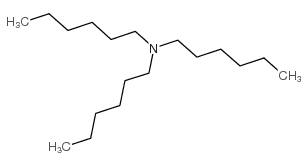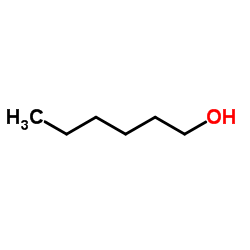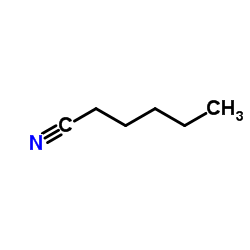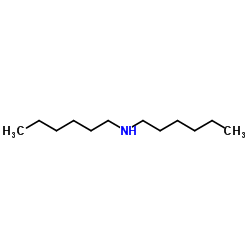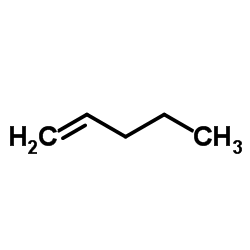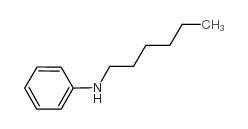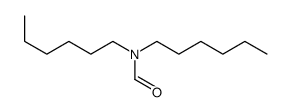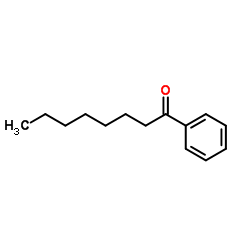102-86-3
| Name | tri-n-hexylamine |
|---|---|
| Synonyms |
1,1',1''-Nitrilotrihexane
TrihexylaMine N-TRIHEXYLAMINE Tri-N-Hexylamine n,n-dihexyl-1-hexanamin tri-n-hexyl amine 1-Hexanamine,N,N-dihexyl EINECS 203-062-9 MFCD00009523 |
| Density | 0.794 g/mL at 25 °C(lit.) |
|---|---|
| Boiling Point | 150-159 °C12 mm Hg(lit.) |
| Melting Point | <-75ºC |
| Molecular Formula | C18H39N |
| Molecular Weight | 269.50900 |
| Flash Point | >230 °F |
| Exact Mass | 269.30800 |
| PSA | 3.24000 |
| LogP | 6.02930 |
| Vapour density | 9.3 (vs air) |
| Vapour Pressure | 0.0103mmHg at 25°C |
| Index of Refraction | n20/D 1.442(lit.) |
Synonym: Section 2 - COMPOSITION, INFORMATION ON INGREDIENTS
Risk Phrases: None Listed. Section 3 - HAZARDS IDENTIFICATION EMERGENCY OVERVIEW
The toxicological properties of this material have not been fully investigated. Potential Health Effects Eye: May cause eye irritation. Skin: May cause skin irritation. Ingestion: May cause irritation of the digestive tract. The toxicological properties of this substance have not been fully investigated. Inhalation: May cause respiratory tract irritation. The toxicological properties of this substance have not been fully investigated. Chronic: Not available. Section 4 - FIRST AID MEASURES Eyes: Flush eyes with plenty of water for at least 15 minutes, occasionally lifting the upper and lower eyelids. Get medical aid. Skin: Get medical aid if irritation develops or persists. Flush skin with plenty of soap and water. Ingestion: If victim is conscious and alert, give 2-4 cupfuls of milk or water. Never give anything by mouth to an unconscious person. Get medical aid. Inhalation: Remove from exposure and move to fresh air immediately. If not breathing, give artificial respiration. If breathing is difficult, give oxygen. Get medical aid. Notes to Physician: Section 5 - FIRE FIGHTING MEASURES General Information: As in any fire, wear a self-contained breathing apparatus in pressure-demand, MSHA/NIOSH (approved or equivalent), and full protective gear. Extinguishing Media: Use water spray, dry chemical, carbon dioxide, or chemical foam. Section 6 - ACCIDENTAL RELEASE MEASURES General Information: Use proper personal protective equipment as indicated in Section 8. Spills/Leaks: Absorb spill with inert material (e.g. vermiculite, sand or earth), then place in suitable container. Section 7 - HANDLING and STORAGE Handling: Wash thoroughly after handling. Use with adequate ventilation. Avoid contact with eyes, skin, and clothing. Keep container tightly closed. Avoid ingestion and inhalation. Storage: Store in a tightly closed container. Store in a cool, dry, well-ventilated area away from incompatible substances. Section 8 - EXPOSURE CONTROLS, PERSONAL PROTECTION Engineering Controls: Use adequate ventilation to keep airborne concentrations low. Exposure Limits CAS# 102-86-3: Personal Protective Equipment Eyes: Wear appropriate protective eyeglasses or chemical safety goggles as described by OSHA's eye and face protection regulations in 29 CFR 1910.133 or European Standard EN166. Skin: Wear appropriate protective gloves to prevent skin exposure. Clothing: Wear appropriate protective clothing to prevent skin exposure. Respirators: Follow the OSHA respirator regulations found in 29 CFR 1910.134 or European Standard EN 149. Use a NIOSH/MSHA or European Standard EN 149 approved respirator if exposure limits are exceeded or if irritation or other symptoms are experienced. Section 9 - PHYSICAL AND CHEMICAL PROPERTIES Physical State: Liquid Color: clear, colorless Odor: Not available. pH: Not available. Vapor Pressure: < 1 mm Hg @ 20 deg Viscosity: Not available. Boiling Point: 263 - 265 deg C @ 760.00mm Hg Freezing/Melting Point: Not available. Autoignition Temperature: Not available. Flash Point: > 112 deg C (> 233.60 deg F) Explosion Limits, lower: Not available. Explosion Limits, upper: Not available. Decomposition Temperature: Solubility in water: Specific Gravity/Density: .7984g/cm3 Molecular Formula: C18H39N Molecular Weight: 269.51 Section 10 - STABILITY AND REACTIVITY Chemical Stability: Stable under normal temperatures and pressures. Conditions to Avoid: Incompatible materials. Incompatibilities with Other Materials: Strong oxidizing agents. Hazardous Decomposition Products: Carbon monoxide, oxides of nitrogen, carbon dioxide. Hazardous Polymerization: Will not occur. Section 11 - TOXICOLOGICAL INFORMATION RTECS#: CAS# 102-86-3 unlisted. LD50/LC50: Not available. Carcinogenicity: Trihexylamine - Not listed by ACGIH, IARC, or NTP. Section 12 - ECOLOGICAL INFORMATION Section 13 - DISPOSAL CONSIDERATIONS Dispose of in a manner consistent with federal, state, and local regulations. Section 14 - TRANSPORT INFORMATION IATA Shipping Name: AMINES, LIQUID, CORROSIVE, N.O.S.* Hazard Class: 8 UN Number: 2735 Packing Group: III IMO Shipping Name: AMINES, LIQUID, CORROSIVE, N.O.S. Hazard Class: 8 UN Number: 2735 Packing Group: III RID/ADR Shipping Name: AMINES, LIQUID, CORROSIVE, N.O.S. Hazard Class: 8 UN Number: 2735 Packing group: III Section 15 - REGULATORY INFORMATION European/International Regulations European Labeling in Accordance with EC Directives Hazard Symbols: Not available. Risk Phrases: Safety Phrases: S 26 In case of contact with eyes, rinse immediately with plenty of water and seek medical advice. S 37/39 Wear suitable gloves and eye/face protection. WGK (Water Danger/Protection) CAS# 102-86-3: No information available. Canada CAS# 102-86-3 is listed on Canada's DSL List. CAS# 102-86-3 is not listed on Canada's Ingredient Disclosure List. US FEDERAL TSCA CAS# 102-86-3 is listed on the TSCA inventory. SECTION 16 - ADDITIONAL INFORMATION N/A |
| Symbol |


GHS07, GHS09 |
|---|---|
| Signal Word | Warning |
| Hazard Statements | H302-H315-H319-H335-H411 |
| Precautionary Statements | P261-P273-P305 + P351 + P338 |
| Personal Protective Equipment | Eyeshields;Faceshields;full-face respirator (US);Gloves;multi-purpose combination respirator cartridge (US);type ABEK (EN14387) respirator filter |
| Hazard Codes | Xi:Irritant; |
| Risk Phrases | R22;R34;R51/53 |
| Safety Phrases | S26-S36-S61 |
| RIDADR | UN 3082 9/PG 3 |
| WGK Germany | 3 |
| Packaging Group | III |
| Hazard Class | 9 |
| HS Code | 2921199090 |
| Precursor 9 | |
|---|---|
| DownStream 9 | |
| HS Code | 2921199090 |
|---|---|
| Summary | 2921199090 other acyclic monoamines and their derivatives; salts thereof VAT:17.0% Tax rebate rate:9.0% Supervision conditions:none MFN tariff:6.5% General tariff:30.0% |

